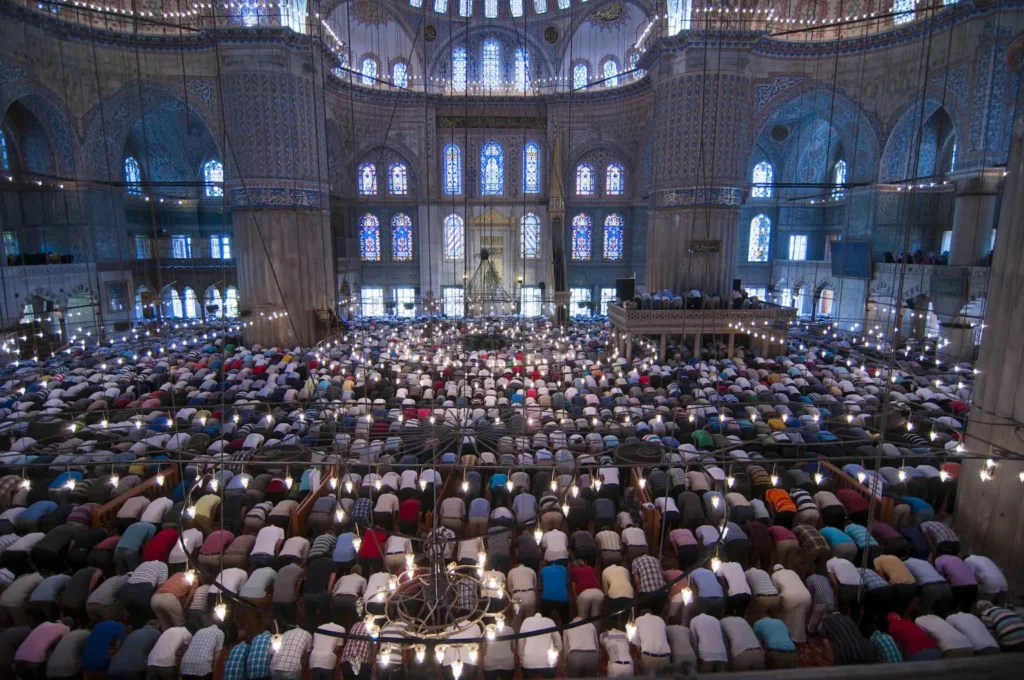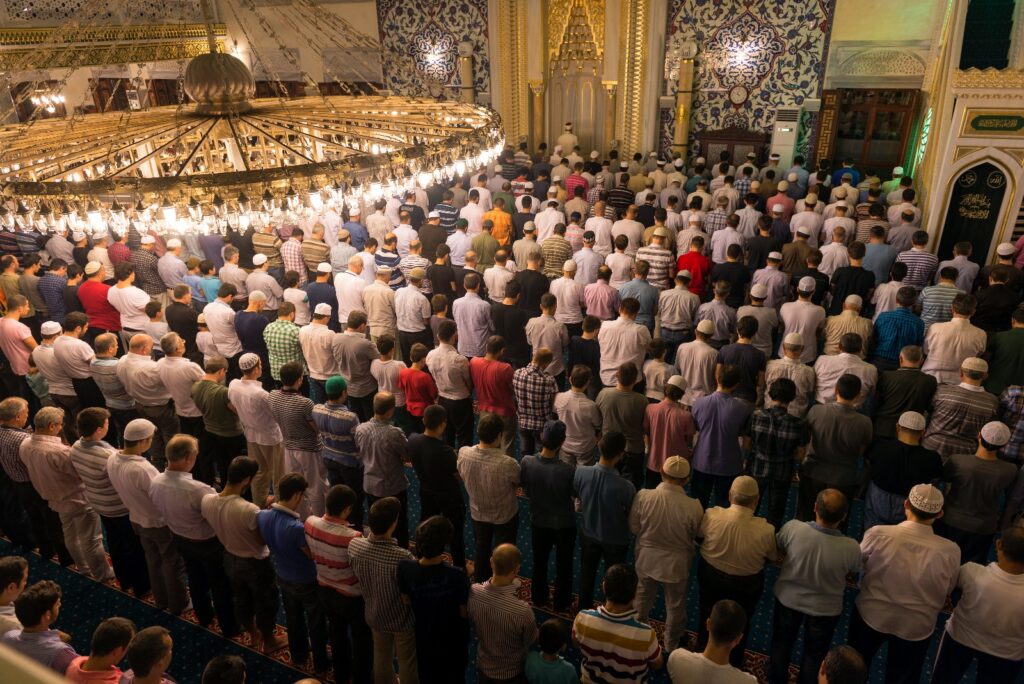Ramadan is the holiest month in Islam, a time of immense spiritual growth, self-discipline, and a heightened connection with Allah (SWT). Muslims worldwide engage in various acts of worship during this blessed month, seeking to earn Allah (SWT)’s mercy, forgiveness, and salvation from the Hellfire. Among the most common practices observed in Ramadan is the night prayer, often referred to as Tarawih.

For centuries, Muslims have gathered in mosques after Isha prayer to perform long congregational prayers, believing them to be a fundamental Sunnah of the Prophet Muhammad (ﷺ). Many assume that this practice of Tarawih is an essential and separate act of worship in Ramadan, distinct from the well-known Qiyam-ul-Layl (standing at night in prayer), also known as Tahajjud. However, a careful and unbiased analysis of the Quran, authentic Hadith, and early Islamic history raises a crucial question:
Did the Prophet (ﷺ) establish a special prayer called Tarawih in Ramadan, or is it simply the same Qiyam-ul-Layl (Tahajjud) that he practiced throughout the year?
A deep dive into Islamic teachings reveals that the Quran consistently emphasizes night prayer (Qiyam-ul-Layl) without making any mention of Tarawih as a distinct prayer. The Prophet Muhammad (ﷺ), too, regularly prayed night prayers—both in and outside of Ramadan—but he did not perform them in congregation as a fixed practice. In fact, he encouraged praying at home rather than in large groups at the mosque. The widely practiced 20/8 Rak‘ahs of Tarawih in congregation was neither commanded in the Quran nor practiced as a regular tradition by the Prophet (ﷺ) himself.
So, where did this practice originate? Was it a divine command, or was it introduced later? If the Prophet (ﷺ) and his closest companions did not establish Tarawih as an institutionalized congregational prayer, then why is it widely observed today?
This documentary aims to explore the historical and religious origins of Tarawih prayer, its differences from Qiyam-ul-Layl, and the teachings of the Prophet (ﷺ) regarding night prayer in Ramadan. Through an in-depth analysis of the Quran, Hadith, and historical accounts, we will try to uncover the truth about Ramadan’s night prayer and determine whether it is better to pray alone at night rather than following the modern congregational Tarawih tradition.
Quranic Evidence – The Night Prayer in Ramadan
Allah (SWT) has given us the Quran as a guide for life. It teaches us how to worship Him in the best way. When we look into the Quran, we see that praying at night is a very special act of worship. It brings a person closer to Allah (SWT) and fills the heart with peace. But does the Quran mention Tarawih as a separate prayer in Ramadan?
Allah (SWT) Commands the Prophet (ﷺ) to Pray at Night
Allah (SWT) instructed the Prophet Muhammad (ﷺ) to wake up in the night and pray. This was a special prayer that gave him strength and a deep connection with his Lord.
🔹 Surah Al-Isra (17:79):
"And rise from sleep for prayer during the night, an extra offering for you. It may be that your Lord will raise you to a praised station."
This verse shows that night prayer is not an obligation but a highly rewarding act of worship. The more we stand before Allah (SWT) in the stillness of the night, the more He raises our ranks.
The Command to Stand in Prayer at Night
🔹 Surah Al-Muzzammil (73:1-4):
"O you who wraps himself [in garments], stand (to pray) all night, except a little—half of it, or a little less, or a little more; and recite the Quran in a slow, measured way."
In this verse, Allah (SWT) calls the Prophet (ﷺ) with love and tells him to stand in prayer during the night. This prayer was not meant just for Ramadan but for all nights. It was a time for deep reflection, recitation, and closeness to Allah (SWT).
Allah (SWT) does not say to pray in a large gathering after Isha. Instead, He tells the Prophet (ﷺ) to stand and pray alone in the stillness of the night.
The True Worshippers Pray at Night
🔹 Surah Al-Furqan (25:64):
"And they who spend [part of] the night to their Lord prostrating and standing [in prayer]."
This verse describes the true servants of Allah (SWT). They do not rush their prayers. They take their time, standing, bowing, and prostrating before Allah (SWT) in the peaceful hours of the night.
The Best Time for Night Prayer
Allah (SWT) praises those who leave their beds to worship Him at night. This is a sign of sincere faith and devotion.
What Do We Learn From the Quran?
🔹 The Quran speaks about night prayer (Qiyam-ul-Layl / Tahajjud), not Tarawih.
🔹 The best time to pray is late at night, before Fajr.
🔹 Allah (SWT) describes those who pray at night as His true worshippers.
🔹 The Prophet (ﷺ) was commanded to pray at night alone, not in large gatherings.
Hadith Evidence – How the Prophet (ﷺ) Prayed at Night in Ramadan
We now turn to the words and actions of the Prophet Muhammad (ﷺ) to understand how he prayed at night during Ramadan. The Hadith, which records his teachings, makes it very clear that the Prophet (ﷺ) never prayed a separate prayer called Tarawih. Instead, he prayed Qiyam-ul-Layl (Tahajjud), alone, at home, during the last part of the night.
Did the Prophet (ﷺ) ever gather people in mosques to pray in congregation after Isha? Did he pray X rak‘ahs of Tarawih? Let’s explore what the most authentic Hadith tell us.
The Prophet (ﷺ) Prayed 8 Rak‘ahs at Night
🔹 Aisha (RA) said:
"The Messenger of Allah (SWT) never prayed more than eleven rak‘ahs, in Ramadan or outside of it. He would pray four, and do not ask how excellent they were. Then he would pray four, and do not ask how excellent they were. Then he would pray three (Witr)."
📖 (Sahih Bukhari 1145, Sahih Muslim 758)
This Hadith tells us important things:
✔️ The Prophet (ﷺ) prayed 8 rak‘ahs + 3 Witr.
✔️ His night prayer was long, deep, and meaningful, not rushed.
✔️ He followed the same pattern in and outside Ramadan.
The Prophet (ﷺ) Prayed at Home, Not in the Mosque
🔹 Aisha (RA) said:
"One night, the Messenger of Allah (SWT) prayed in the mosque, and some people prayed behind him. Then the next night, more people gathered. On the third or fourth night, the Prophet (ﷺ) did not come out. In the morning, he said: ‘I feared that it would be made obligatory upon you.’"
📖 (Sahih Bukhari 2010, Sahih Muslim 761)
Here, the Prophet (ﷺ) saw that people were starting to follow him in prayer. But instead of encouraging them, he stopped coming to the mosque. Why?
The Prophet (ﷺ) Encouraged Praying at Home
🔹 The Prophet (ﷺ) said:
"The best prayer a person can offer is the one he offers at home, except for the obligatory prayers."
📖 (Sahih Bukhari 731, Sahih Muslim 781)
The Prophet (ﷺ) Prayed in the Last Part of the Night
🔹 The Prophet (ﷺ) said:
"Our Lord descends every night to the lowest heaven when one-third of the night remains and says: ‘Who will call upon Me so that I may answer him? Who will ask of Me so that I may give him? Who will seek My forgiveness so that I may forgive him?’"
📖 (Sahih Bukhari 1145, Sahih Muslim 758)
A Moment to Reflect
If the Prophet Muhammad (ﷺ) himself did not make Tarawih a separate prayer, and he prayed alone, at home, late at night, then why do we do it differently?
The Introduction of Tarawih During Umar’s Caliphate
Islam is a religion based on the Quran and the Sunnah of the Prophet Muhammad (ﷺ). Whatever he did, we follow. Whatever he avoided, we avoid. But if we look at history, we find something interesting:
The Prophet (ﷺ) never established Tarawih as a regular, congregational prayer. It was not something the Sahabah (companions) prayed every night in the mosque during his lifetime.
So where did the Tarawih prayer in congregation come from?
The answer is: It started during the Caliphate of Umar ibn al-Khattab (RA). Let’s look at the historical evidence.
Umar (RA) Saw People Praying in Small Groups
After the death of the Prophet (ﷺ), the Sahabah continued to pray Qiyam-ul-Layl (Tahajjud) at home, alone, just as the Prophet (ﷺ) used to do. However, in the time of Umar ibn al-Khattab (RA), something new happened.
🔹 Narrated by Abdur Rahman ibn Abdul Qari:
"I went to the mosque with Umar ibn al-Khattab (RA) one night in Ramadan. We saw people praying in different groups. Some were praying alone, some in small groups. Umar (RA) said, ‘I think it would be better if they all prayed behind one Imam.’ So he appointed Ubayy ibn Ka‘b to lead them in prayer."
📖 (Sahih Bukhari 2010)
This was the first time Tarawih was prayed in congregation as a daily practice in Ramadan. Before this, it was never a fixed tradition.
Umar (RA) Called It a “New Practice (bid‘ah)”
When Umar (RA) saw the people praying together behind one Imam, he said something very important.
🔹 Umar (RA) said:
"What a good innovation (bid‘ah) this is! But the prayer that they are neglecting (tahajjud) is better than the one they are performing!"
📖 (Sahih Bukhari 2010, Muwatta Malik 1/115)
This statement is shocking. Umar (RA) himself called it a bid‘ah (innovation).
Why? Because the Prophet (ﷺ) never made it a regular, congregational prayer.
This means that Tarawih as we know it today was not established by the Prophet (ﷺ), but by Umar (RA) as a way to organize the people.
Did All the Sahabah Agree With Umar (RA)?
Not all of the Sahabah followed this new way of praying in congregation. Many of them continued to pray at home, just as the Prophet (ﷺ) did.
Even famous scholars later said that praying at home is better:
🔹 Imam Malik (RA) said:
"The Sunnah of the Prophet (ﷺ) is dearer to us than what was introduced later."
📖 (Al-Muwatta 1/115)
🔹 Imam Abu Hanifa (RA) said:
"It is better to pray Qiyam-ul-Layl at home than in the mosque."
📖 (Fatawa Hindiyyah 1/116)

Final Message – A Call to the Heart
As we stand in the blessed nights of Ramadan, under the sky filled with Allah (SWT)’s mercy, let us take a moment to reflect. Are we following the way of our beloved Prophet Muhammad (ﷺ)? Are our prayers bringing us closer to Allah (SWT) in the way He loves?
The Prophet (ﷺ), the most beloved to Allah (SWT), would wake up in the quiet hours of the night, when the world was asleep, and stand before his Lord in deep prayer. His heart was full of love and humility, his eyes would fill with tears, and his lips would softly recite the Quran—not in a rush, but with meaning and reflection.
This was his way, his special way of worshiping Allah (SWT) in Ramadan and throughout the year. Not in large crowds but as a private conversation with his Creator, alone, in the last part of the night.
But today, many of us have made something else a habit. We rush to the mosques, thinking that praying in a big group, finishing the Quran quickly, and following a set pattern is the best way to worship. But where is the personal connection with Allah (SWT)? Where is the quiet prayer that comes from the heart?
Ramadan is not just about following routines. It is about renewing our connection with Allah (SWT). It is about stepping away from distractions and worshiping in the way that pleases Him most.
Tonight, and every night of Ramadan, let us revive the way of the Prophet (ﷺ).
Let us wake up in the last part of the night, when the world is quiet.
Let us stand in prayer, not for others to see, but to bring our hearts closer to Allah (SWT).
Let us whisper our du‘as, shed our tears, and seek the love of the One who loves to forgive.
Because in the end, when our deeds are weighed, it will not matter how many people prayed beside us, but how sincerely we prayed before Allah (SWT).
May Allah (SWT) guide us back to His way, the way of the Prophet (ﷺ), the way of true devotion. Ameen.
